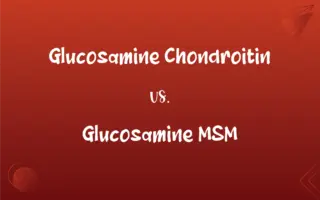Proteoglycans vs. Glycosaminoglycans: What's the Difference?
Edited by Aimie Carlson || By Janet White || Published on January 25, 2024
Proteoglycans are molecules in cell membranes composed of a core protein with glycosaminoglycan chains; glycosaminoglycans are long, unbranched polysaccharides that attach to these proteins.

Key Differences
Proteoglycans are large molecules found in the extracellular matrix, consisting of a core protein and one or more glycosaminoglycan (GAG) chains. Glycosaminoglycans are these specific polysaccharide chains that attach to the core protein of proteoglycans, playing a crucial role in cell signaling and structural integrity.
The primary function of proteoglycans is to provide structural support and mediate cell signaling in various tissues. Glycosaminoglycans, as components of proteoglycans, contribute to these functions by retaining water, which aids in tissue hydration and resilience.
In terms of structure, proteoglycans are diverse, with the core protein determining their specific type and function. Glycosaminoglycans, on the other hand, are linear chains of repeating disaccharide units, differing in sugar composition and sulfation patterns.
Proteoglycans are essential in joint health, particularly in cartilage, where they provide cushioning and resistance to compression. Glycosaminoglycans, such as hyaluronic acid and chondroitin sulfate, are key components of these proteoglycans in cartilage.
In research and medicine, proteoglycans are studied for their roles in cell growth, development, and pathologies. Glycosaminoglycans are of interest for their potential in therapeutic applications, such as in osteoarthritis treatment and skin repair.
ADVERTISEMENT
Comparison Chart
Composition
Core protein with attached GAG chains.
Long, unbranched polysaccharides, often part of proteoglycans.
Function
Provide structural support, mediate cell signaling.
Retain water, contribute to tissue hydration and resilience.
Structure
Varied, dependent on core protein type.
Linear chains of repeating disaccharide units.
Role in Tissues
Crucial in cartilage, skin, and other tissues.
Integral to proteoglycans' function in these tissues.
Medical Importance
Studied for roles in growth, development, pathology.
Potential therapeutic applications in various treatments.
ADVERTISEMENT
Proteoglycans and Glycosaminoglycans Definitions
Proteoglycans
Diverse in structure and function, depending on the core protein.
Different types of proteoglycans are involved in various cellular processes.
Glycosaminoglycans
Integral to the function of proteoglycans in tissues.
Glycosaminoglycans are important for the structural integrity of skin.
Proteoglycans
Involved in cellular signaling and growth.
Proteoglycans are crucial in the development and repair of connective tissues.
Glycosaminoglycans
Have potential therapeutic applications in medicine.
Hyaluronic acid, a type of glycosaminoglycan, is used in skin repair treatments.
Proteoglycans
Found in the extracellular matrix, contributing to tissue resilience.
The abundance of proteoglycans in cartilage contributes to its shock-absorbing properties.
Glycosaminoglycans
Play roles in cell signaling and tissue hydration.
Glycosaminoglycans are essential for maintaining the hydration of extracellular matrix.
Proteoglycans
Molecules in cell membranes composed of a core protein and GAG chains.
Proteoglycans in the skin help maintain its elasticity and hydration.
Glycosaminoglycans
Vary in sugar composition and sulfation.
Different types of glycosaminoglycans perform distinct functions in the body.
Proteoglycans
Essential for structural integrity and cell communication.
Proteoglycans play a key role in cartilage function and joint health.
Glycosaminoglycans
Long, unbranched polysaccharides attached to proteoglycans.
Glycosaminoglycans in joint cartilage help retain water for cushioning.
Proteoglycans
Plural of proteoglycan
Glycosaminoglycans
Any of a group of unbranched polysaccharides with high molecular weight that contain amino sugars and often are attached to or form complexes with proteins. Also called mucopolysaccharide.
Glycosaminoglycans
Plural of glycosaminoglycan
FAQs
What are glycosaminoglycans?
Long, unbranched polysaccharides, often part of proteoglycans.
Where are proteoglycans found in the body?
In the extracellular matrix of various tissues, including cartilage and skin.
Can glycosaminoglycans be synthesized artificially?
Yes, for use in pharmaceuticals and cosmetic products.
Do proteoglycans vary in structure?
Yes, depending on the type of core protein they contain.
How are proteoglycans studied in research?
Through their roles in cell growth, development, and pathology.
How do proteoglycans contribute to joint health?
They provide cushioning and resistance to compression in cartilage.
Are glycosaminoglycans used in medical treatments?
Yes, particularly in osteoarthritis treatment and skin repair.
Can glycosaminoglycans be found independently of proteoglycans?
Yes, though they often function as part of proteoglycans.
What is the role of glycosaminoglycans in skin health?
They help maintain skin hydration and elasticity.
What are proteoglycans?
Molecules consisting of a core protein and attached glycosaminoglycan chains.
What is the main function of glycosaminoglycans?
To retain water and contribute to tissue hydration and resilience.
How do proteoglycans affect cell communication?
They play roles in cell signaling and growth regulation.
Are proteoglycans and glycosaminoglycans involved in disease processes?
Yes, in conditions like osteoarthritis and certain skin disorders.
Are glycosaminoglycans uniform in all tissues?
No, their type and concentration vary depending on the tissue.
What differentiates glycosaminoglycans from each other?
Their sugar composition and sulfation patterns.
Do proteoglycans change with age?
Yes, their composition and function can alter, affecting tissue health.
Are glycosaminoglycans important for wound healing?
Yes, especially in skin repair and regeneration.
How do proteoglycans impact tissue engineering?
They are key factors in developing artificial tissues and organs.
Can proteoglycans be targeted in cancer therapy?
Some research suggests they may be targets due to their role in cell signaling.
What is the significance of glycosaminoglycans in hydration?
They are vital for retaining moisture in tissues.
About Author
Written by
Janet WhiteJanet White has been an esteemed writer and blogger for Difference Wiki. Holding a Master's degree in Science and Medical Journalism from the prestigious Boston University, she has consistently demonstrated her expertise and passion for her field. When she's not immersed in her work, Janet relishes her time exercising, delving into a good book, and cherishing moments with friends and family.
Edited by
Aimie CarlsonAimie Carlson, holding a master's degree in English literature, is a fervent English language enthusiast. She lends her writing talents to Difference Wiki, a prominent website that specializes in comparisons, offering readers insightful analyses that both captivate and inform.































































